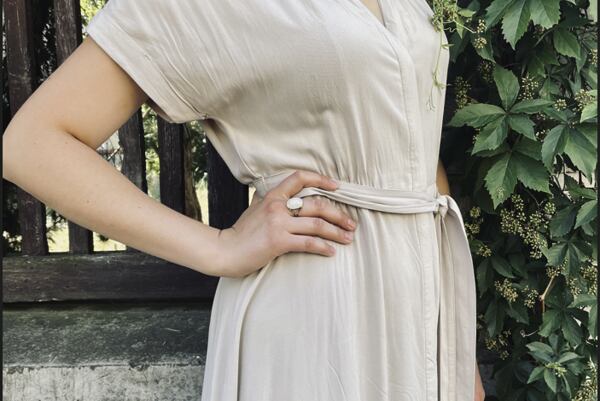Rayon is a semi-artificial fiber made in much the same way as some synthetics but derived from the plant-based material cellulose. Cotton, linen, hemp, and other natural fibers also consist primarily of cellulose, which is why rayon is so like them in so many ways, such as its breathability and requirements for care.
The cellulose that goes into rayon is usually obtained from wood or from waste produced in the cotton refining process. To make rayon, cellulose is converted into a thick, viscous liquid, which is why the fabric is sometimes called viscose. This honey-like substance is then squeezed through tiny holes into an acid bath, where it becomes a solid fiber.
By manipulating the production process, a manufacturer can create fibers with various attributes, making materials that are especially light, good at wicking away moisture, or very durable.
What about viscose?
The term viscose is sometimes used interchangeably with rayon to refer to any regenerated cellulose fiber, including modal, lyocell, and others. That usage is not entirely accurate. In a stricter sense, the term viscose refers only to rayon fibers derived using the viscose process, which makes the other rayon fibers its siblings, not its sub-sets. In other words, all viscose is rayon, but not all rayon is viscose.
Guidelines in the United States (and China and Japan) say that a fiber made from regenerated cellulose is rayon. International ISO norms, upon which the US guidelines are based, use the term viscose instead of rayon. Even so, it sometimes happens that items are labeled as 40% rayon, 60% viscose, for example. In such cases this might indicate a mix of viscose rayon and some other kind of rayon.
Rayon fibers
European guidelines recognize six types of artificially produced cellulose fabric. Here is a brief overview.
Viscose
This is a rayon fiber produced using the viscose process, which was developed over a century ago. It is “ordinary” rayon, used primarily for making tee-shirts and light summer dresses or slacks. Viscose rayon is soft, comfortable, airy, cool, and inexpensive. Its downsides are that it is not very sturdy and can tend to pill. It weakens when wet, so it should be washed as a delicate and wrung and dried carefully to prevent deformation. It should also be noted that viscose rayon tends to wrinkle, but how much depends on the type of fabric. A tee-shirt made of a rayon-elastane mix will wrinkle less than a light summer fabric.
Viscose production is not environmentally friendly. It creates waste by-products that are not recyclable. Viscose itself is biodegradable, much like cotton.
Modal
Modal is obtained by a modified viscose process that makes it much more durable, especially when wet, thus eliminating one of the traditional weaknesses of rayon. It is also more resistant to pilling, so it has practically no drawbacks except that it is slightly more expensive than ordinary rayon. Modal is easy to fall in love with. It is so fine and smooth that its only real competition is pure silk.
MicroModal™ and MicroModal AIR™ are especially fine modal fibers produced by the Austrian company Lenzing. The cellulose used in producing modal is derived from beech trees.
Cupro
Cupro is a reconstituted cellulose fiber derived using the cuprammonium method. Although this may sound dangerously “chemical,” the process recycles everything, much as with lyocell. In addition, the raw material used is a waste by-product of cotton processing, making cupro an environmentally friendly material.
Cupro is light, airy, and cool. It has a slightly silky sheen, drapes well, and is often used in place of silk. A drawback is that it tends to wrinkle.
Lyocell (Tencel)
The production of lyocell uses a special dissolution and spinning process. The solvent used is virtually 100% recyclable and is not disposed of but reused in the manufacturing process. Lyocell fabrics have properties similar to modal: they are light, soft, very comfortable, and at the same time more durable than ordinary rayon.
Tencel™ is the trade name for lyocell made by Lenzing. The cellulose used in its production is derived from eucalyptus trees.
Bamboo
Bamboo rayon is made from cellulose derived from bamboo. Its qualities are determined by how it is produced. It can behave like an ordinary viscose rayon, losing fibers and pilling, or it can be soft and durable. Aside from a pleasant, soft touch, bamboo doesn’t actually lend fabrics the additional special qualities sometimes claimed by manufacturers – as a matter of fact, all types of rayon are cool, absorbent, and hypoallergenic.
Textile labelling requirements prohibit the use of the term “bamboo” on its own unless the fabric actually contains bamboo bast. For bamboo rayon, the tag must read “rayon (or viscose) made from bamboo.”
Acetate and triacetate
These two fibers are produced from cellulose acetate and are very similar in their chemical makeup. Acetate has been around for a while; in the years between the world wars it was manufactured as a silk substitute. Today it is most often used to make breathable linings, but also turns up in satins, taffetas, and brocades for evening wear.
Acetate is supple, shiny, and drapes well, but it is not very durable, and the fabric is susceptible to abrasion. Acetate is different from viscose in one other aspect, its malleability when heated. This is useful for pleating, but acetate fabrics must be ironed at a very low temperature and cannot be dried in a tumble dryer.
HWM
You may have run across the acronym HWM. It means “high wet modulus” and indicates that the fabric has a high wet strength. HWM is an improved form of rayon. You won’t see this written on clothing labels because HWM fibers fall under the modal or lyocell categories, but sometimes this abbreviation will turn up in descriptions of rayon products.







Comments(1)